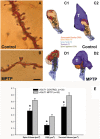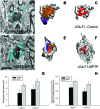Morphological changes of glutamatergic synapses in animal models of Parkinson's disease
- PMID: 26441550
- PMCID: PMC4585113
- DOI: 10.3389/fnana.2015.00117
Morphological changes of glutamatergic synapses in animal models of Parkinson's disease
Abstract
The striatum and the subthalamic nucleus (STN) are the main entry doors for extrinsic inputs to reach the basal ganglia (BG) circuitry. The cerebral cortex, thalamus and brainstem are the key sources of glutamatergic inputs to these nuclei. There is anatomical, functional and neurochemical evidence that glutamatergic neurotransmission is altered in the striatum and STN of animal models of Parkinson's disease (PD) and that these changes may contribute to aberrant network neuronal activity in the BG-thalamocortical circuitry. Postmortem studies of animal models and PD patients have revealed significant pathology of glutamatergic synapses, dendritic spines and microcircuits in the striatum of parkinsonians. More recent findings have also demonstrated a significant breakdown of the glutamatergic corticosubthalamic system in parkinsonian monkeys. In this review, we will discuss evidence for synaptic glutamatergic dysfunction and pathology of cortical and thalamic inputs to the striatum and STN in models of PD. The potential functional implication of these alterations on synaptic integration, processing and transmission of extrinsic information through the BG circuits will be considered. Finally, the significance of these pathological changes in the pathophysiology of motor and non-motor symptoms in PD will be examined.
Keywords: Parkinson’s disease; astrocytes plasticity; glutamatergic synapses; striatum; subthalamic nucleus; synaptic plasticity; vGluT.
Figures




References
-
- Aymerich M. S., Barroso-Chinea P., Pérez-Manso M., Muñoz-Patiño A. M., Moreno-Igoa M., González-Hernández T., et al. . (2006). Consequences of unilateral nigrostriatal denervation on the thalamostriatal pathway in rats. Eur. J. Neurosci. 23, 2099–2108. 10.1111/j.1460-9568.2006.04741.x - DOI - PubMed
Publication types
Grants and funding
LinkOut - more resources
Full Text Sources
Other Literature Sources

